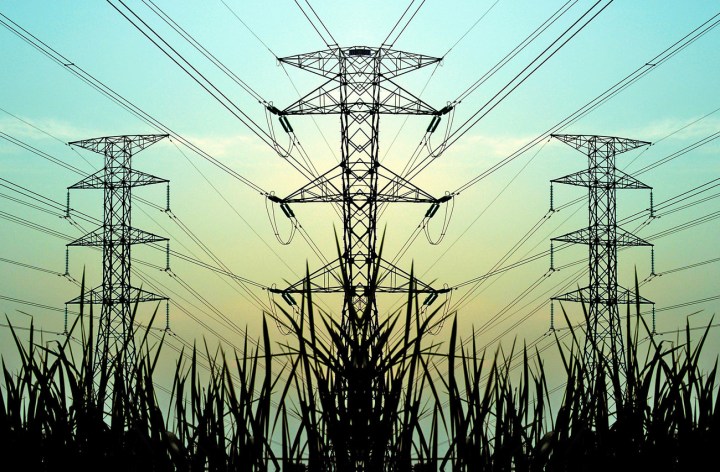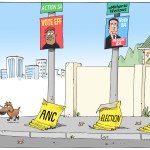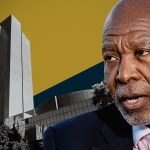THE GATHERING ESSAY
SA’s burning question — what’s holding back the reform of the energy sector?

Is it the spectre of Mbeki’s removal? Does Ramaphosa fear that he will lose traction with the unions — his original base inside the party which has the machinery to campaign on a larger scale than the ANC itself?
The energy crisis in South Africa has its roots in a series of policy failures and missteps.
In the 1990s, electricity was plentiful and cheap, even though the state had initiated a vast distribution programme to extend the network to those excluded under apartheid. A low-cost, coal-fired fleet was producing surplus energy at one of the best prices in the world. The South African economy was powering up and would, in the early 2000s, enjoy growth of more than 5% for consecutive years.
At the heart of the energy network was the giant parastatal Eskom, a beacon of cheap and efficient power production, but somewhat out of tune with the global trend towards modernising production to make it more responsive to market demand.
Then South Africa created the worst of both worlds for a state-run enterprise and a private sector looking to invest. The 1998 energy white paper foresaw new investment being made by the private sector, but the government was a reluctant suitor. This pattern has been repeated many times since, leading up to the current crisis.
Its immediate cause is poor management and maintenance and equipment near the end of its lifespan. But the deeper roots lie in a paralysing combination of ideology and the nature of the political economy, specifically the ANC’s political economy and the comrades with interests in coal.
The 1998 white paper actually foresaw that the country would run out of electricity by 2007 due to increasing demand and poor maintenance, but the government failed to get the projected new private investment in energy production off the ground.
When the Department of Minerals and Energy finally invited proposals for increasing power production by 1,000MW a year from 2007, the private sector was hesitant, as it was explained that Eskom would retain market dominance and control at least 70% of generation.
As a result, when the predicted shortfall came in 2007 and 2008, Eskom introduced a new phenomenon, “load shedding”, a euphemism for dropping sections of the grid because there was insufficient power supply.
Panicked by the shortfall, the government responded by authorising Eskom to build on a scale never seen before. Two power stations — initially codenamed Alpha and Bravo and later named Medupi and Kusile — each producing a mammoth 4,800MW, would be rapidly constructed to plug the generation hole.
Eskom, now bereft of the project management, engineering and procurement skills it had lost when the government said it no longer needed to build power stations, found itself managing two of the largest power station builds on the planet.
Visit Daily Maverick’s home page for more news, analysis and investigations
Failure on a grand scale
The scale of these build programmes was astonishing, matched only by the scale of their failure. Over budget, under capacity and at the centre of the State Capture feeding frenzy, they have cost the country hundreds of billions of rands and thrust Eskom (and thus the state) deep into debt.
On the eve of the party congress that would elect Jacob Zuma, Thabo Mbeki issued an apology for the crisis. “Eskom was right and the government was wrong,” he said of the decision to halt new power station builds almost a decade earlier.
During Zuma’s “lost decade”, no policy adjustments were made and the crisis grew worse as Eskom became a parking lot for unskilled party cadres on bloated salaries, as the feeding frenzy intensified with coal contracts going to the Guptas.
Ramaphosa’s ascension to power as ANC president in December 2017 — now five years ago — was supposed to usher in a new era of reform to address the power problem.
A two-pronged strategy — clean out the rot in Eskom and develop a new energy plan that allows for private generation — appeared to be the strategy.
There has been a concerted effort to cut out the rot, although much remains. The trouble is, it is not just the rot of State Capture, but also that of decades of “cadre deployment”.
In his State of the Nation Address in February 2019, Ramaphosa produced a hoary chestnut: Eskom was to be broken into three parts — generation, transmission and distribution. This would expose the true balance sheets of the three businesses and open them to private-sector funding.
The government supported Eskom’s “nine-point turnaround plan” which sought to cut costs while bolstering earnings by getting municipalities to cough up what they owed. Eskom, it was stated, needed “a new business model” which would address the crisis and outline a pivot to clean energy.
Ramaphosa repeatedly emphasised the speed with which these actions were to be undertaken.
“It is imperative that we undertake these measures without delay to stabilise Eskom’s finances, ensure security of electricity supply, and establish the basis for long-term sustainability,” said the President.
Nearly four years later, South Africa remains stuck in the throes of its worst energy crisis yet, with power being switched off regularly and the economy teetering on the brink of collapse.
While there has been some progress in issuing renewable contracts, there remain loud public contests over policy. It does not help that there are two ministers — the minister of public enterprises, Pravin Gordhan, and a self-proclaimed coal fundamentalist, Gwede Mantashe — who are in charge of energy production.
There is also confusion.
In one of the more colourful interpretations of the power of competition in a free market, Ramaphosa proposed creating a second state-owned energy company to compete with Eskom, apparently emulating China’s model of market competition. Mantashe eagerly backed him, saying that such an entity would fall under his department, competing with Eskom, which fell under Gordhan. While the emergency measure to allow companies to generate 100MW of their own power through renewables appeared to be a loosening of the shackles, for such investment to be justified, these projects would have to be “grid-tied” — powering up the grid with a surplus when this was available. To achieve this, they have to acquire a grid permit from none other than the coal fundamentalist himself.
Instead, by March this year, Eskom was burning 9 million — 9 million! — litres of diesel a day to plug the energy gap, and SA remains the world’s worst coal polluter in proportion to population size.
What’s holding back the reform of the energy sector? Is it the spectre of Mbeki’s removal? Does CR fear that he will lose traction with the unions — his original base inside the party which has the machinery to campaign on a larger scale than the ANC itself? Has he feared Mpumalanga — South Africa’s swing state which sealed his rise to power — will baulk at the loss of coal jobs and the industrial ecosystem around this which is located in that province? Does he want to preserve the route to a gas revolution to appease the Russians, among whom is the party’s largest funder, the Russian oligarch Viktor Vekselberg? Does the President fear the backlash that would result from displacing the vast network of party officials who benefit from the network of coal mining and trucking contracts that clog up Eskom’s arteries? Some have spoken of a controlled crash landing as the best Eskom case in the current circumstances: is this possible?
Whatever the reason, and the outcome, the energy crisis and these policy and leadership missteps have created a clear and present danger to South Africa’s economic prospects.
The same questions about power can be asked of the political economy of rail, once the 11th-largest network in the world, which has been stripped of its capacity, cabling and customers in favour of road traffic. Whereas rail handled 30% of all traffic in SA at the turn of the century, today that figure has been halved. Attempts to reinvest in rolling stock have also been mired in controversy and corruption.
Finally, South Africa’s ports remain similarly problematic, a significant obstacle to lowering trade costs, with the three largest ports, Ngqura, Cape Town and Durban, ranking 363, 364 and 365 (out of 370 ports reviewed) in the World Bank’s 2021 Container Port Efficiency Index. The pace of their promised partial concessioning remains, too, hesitantly slow.
Thus, several questions stand out:
- What does a controlled crash landing for Eskom look like? Can it take off again?
- Why has the pace of reform in these key areas of infrastructure been so slow?
- Is the problem primarily technical or political?
- Can South Africa’s economic needs and political system be aligned more productively? What has to change to permit this?
- What key decisions does the government have to make, and what are the priorities for implementation?
- Can the reform spoilers be isolated?
- What is the prospect for radical solutions: provincial devolution of infrastructure responsibilities, for instance? Are there other radical reforms that we are overlooking?
- Are there realistic road markers which can inform us of the pace and direction of change? DM
Dr Greg Mills is the Director of The Brenthurst Foundation.



















At ‘The Gathering’ Andre de Ruyter gave a very positive talk about reorganising the power supplies in SA. I found Greg Mills very pessimistic, giving no credit to the Eskom CEO’s talk. He should follow de Ruyter’s example and stop talking about a ‘controlled crash landing’ for Eskom.
“ what’s holding back the reform of the energy sector?”. Easy : Mr or more likely Mrs Mantashe. While they tread mud, the rest of us implement plans to wean off the grid. See you in 2045